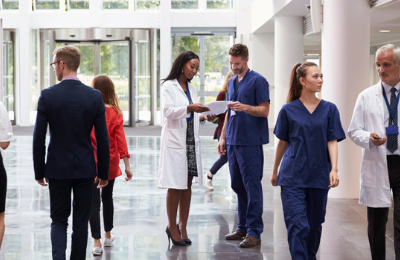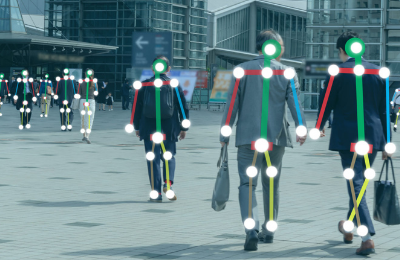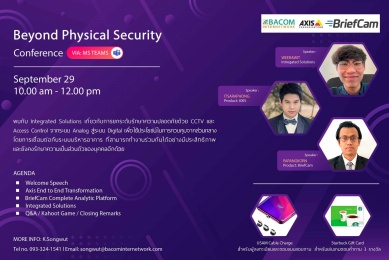Driving public health and safety at hospitals When thinking of ways to improve health and safety at a hospital or healthcare facility, video surveillance might not be the first thing that comes to mind. However, video analytics software is a crucial tool in safeguarding patients and staff. Whether it be an external threat or optimizing care, surveillance data can and should be used to assist hospitals in their strategic planning to increase operational intelligence and drive efficiencies with public health and safety in mind. From ambulance bays, emergency departments and patient care floors to cafes and parking areas, video surveillance analytics software can assist management in making critical decisions that lead to increased care and safety. Optimizing traffic to improve patient care On the surface, optimizing pedestrian and vehicle traffic and utilizing space effectively in a hospital might not seem related to public health and safety, but it could make a difference in how quickly patients receive care. Understanding how visitors interact with the facility is key to improving its layout, signage, placement of informational kiosks and displays. Video analytics software aggregates video surveillance data captured over time so administrators can see the big picture when it comes to navigational patterns, as well as where, when, and how much time pedestrians spend in particular areas. Footfall reporting provides accurate data regarding peak traffic times and problem hotspots, as well as unique, bounce and return visits to specific areas of the facility. For example, footfall navigational data can determine the paths patients take to different departments throughout the hospital, and how long it takes them to get there. Are they taking the most efficient route? Are they getting lost and arriving for their appointment or procedure late? Could changing directional signage improve their experience? Video surveillance software data could shed light on these questions. Similarly, video surveillance software can be used to track traffic vehicle movement around the hospital’s campus. This could be particularly helpful in examining traffic flow around the hospital and optimizing so that visitors can be dropped off or park and enter the facility efficiently. Additionally, dwell-time reports and real-time alerting can help notify staff when there are back-ups in the ambulance bay. Aggregating this data over time can lead to improvements in ambulance bay layout or protocols, ultimately enhancing patient care. Driving health & safety by deriving operational intelligence Demographic intelligence, behavioral heatmaps, and data visualizations can help hospital administrators make strategic decisions that impact patients, visitors, and staff alike. Historic heatmaps combined with rule-based, real-time alerting enables both long- and short-term situational awareness, assessment and response, whether to developing situations, such as crowds forming in the ER waiting room, or space utilization inefficiencies that are identified for that department. In real-time, staff can prioritize patient care and proactively divert ambulances to neighboring hospitals, if needed, by being alerted to crowd formations. At the same time, heatmap data can be used to optimize waiting room layout to maximize social distancing; and historical, aggregated video surveillance data can help teams proactively prepare for peak traffic and staff accordingly. Not only can real-time video surveillance alerting enhance the patient experience, it can lead to the mitigation of threats. Alerts can be set to trigger a notification when a person has been dwelling in unauthorized areas for unexpected amounts of time, thereby helping staff take action against bad actors and external threats to the hospital. Lastly, forensic search capabilities enable administrators to investigate an incident in a timely manner to understand what happened, pinpoint people of interest, clear false claims and even reduce potential litigation. Perhaps there was a slip and fall claim; forensic review of video data can determine whether it was a legitimate accident. Furthermore, review of the incident could lead to increased safety protocols to reduce future incidents. Maintaining facilities Maintaining clean facility is of the utmost importance in a hospital. Utilizing a video surveillance software system is one way to improve efficiency and create a cleaner environment by planning maintenance schedules based on actual facility usage, rather than traditional time-based schedules. Video surveillance software aggregates data into heatmaps and dashboard reports to show usage patterns and volumes, and can trigger real-time, rule-based alerts to notify maintenance managers when a customized threshold of visitors has been reached. The same set of features could be applied to the hospital cafeteria to identify peak traffic and down times. This information helps managers to staff and order accurately. As hospitals and healthcare workers find themselves working harder than ever to respond to mounting demand for emergency care, optimizing patient, visitor and staff safety and comfort is critical. By leveraging existing surveillance networks to enable intelligent, timely decision making, hospital managers can support these audiences and proactively meet their needs, delivering the highest quality of patient care and employee services.
อ่านต่อWhat it is object detection and recognition When it comes to video surveillance analytics, object detection and identification is a crucial component. This capability empowers operators to locate a specific object, such as a person, vehicle, or backpack, and then track it from frame to frame. The result? The ability to quickly identify the object through hours of footage, thereby giving security and police investigators critical forensic evidence; business owners much-needed insights; and more impactful applications for a diverse set of users. To break it down, object detection is simply the ability to detect objects in video – however, this process is far from simple when executed by an advanced technology. The first step, “object extraction,” detects and tracks an object at any given time. Then, another technology called “background/foreground separation” is added, which identifies a static background of the scene. The ability to extract objects from video and differentiate them from the backdrop against which they are detected, enables more sophisticated video analytic activity, such as forensic search, real-time alerting, or VIDEO SYNOPSIS® technology – which displays all extracted video objects simultaneously, so that the full activity of the hours-long scene can be viewed all at once, rather than in linear time. How object detection and recognition works So, how is object detection – and subsequent object recognition – made possible? Through artificial intelligence. We encounter artificial intelligence and deep learning throughout our day, through tools such as voice recognition or automatic translation services; deep learning is an AI-backed discipline by which computers learn through exposure to data and execute task such as identifying objects or recognizing an object throughout a video. In order for deep learning to be successful, you need vast amounts of data, which must be processed and annotated. This data is then used to train the network until it is able to repeat what it has been trained to do. In terms of object detection and recognition, the training data (which, in the case of video analytics, is video itself), will be broken down to individual frames to extract every item or object and train the system’s deep learning neural networks to associate specific objects with their classification and attributes. For example, if investigators are looking for a missing child wearing pink pants, they can leverage video analytics to search video evidence for objects that the system can recognize are people wearing pants that are pink. The user would filter his or her search based on these attributes, and the video analytics software – having been exposed to large data sets of people, pink objects, and pants – would be able to answer a query against actual footage: ‘identify all instances of people wearing pink pants.’ In order to detect matches, the deep learning algorithm will need to know what pink is and will need to have been fed thousands of data examples of this color. This is repeated ad infinitum for as many objects are required. Object tracking It is not enough that an object be detected, it must also be tracked. For any video search – whether as part of a law enforcement investigation or a way to gain deeper business intelligence – it is important to be able to accurately follow the object from the time it enters the scene until the time is leaves the scene, even if there is an obstruction or crowd. Once the object is detected and tracked, descriptive information (or metadata) can be applied to it to create a vast structured database of classified objects. This step is what allows the technology to quickly examine hours of footage to identify the specific object – or, in our example, the pink pants. When is it used? Object detection and recognition can be used before, during and after an event occurs. Reviewing capabilities allow for the investigation of an event that has already occurred. But real-time alerting can also be enabled, which allows for the response to an event as it is happening in order to identify objects of interest. Object detection and recognition also has applications beyond law enforcement. For example, a real-time alert can be set for a specific camera at the entrance of a construction site to ensure that everyone who passes is wearing a hard hat. If someone were not wearing the designated object, in this case an orange hard hat, an alert would be sent to operators who could then respond in real-time. Object detection and recognition are important underlying technological capabilities that drive sophisticated video analytics for diverse business and security use cases. Want to learn how video analysis can streamline your day-to-day decision making with actionable intelligence? Take the BriefCam Business Case Assessment.
อ่านต่อเมื่อวันที่ 16-18 พฤศจิกายน 2564 ทางบริษัทเบคอม อินเตอร์เน็ทเวอร์ค จำกัด ได้จัดงาน Webinar ในหัวข้อ A&E for world class security design ทางบริษัทฯ ใคร่ขอขอบคุณทีมงานทุกฝ่ายที่ช่วยงานสัมมนาครั้งนี้ให้สำเร็จลุล่วงไปได้ด้วยดี ขอขอบคุณลูกค้าทุกท่านที่ให้เกียรติสละเวลามาร่วมเป็นส่วนหนึ่งในงานสัมมนา ตลอดจนให้ความสนใจในผลิตภัณฑ์ของบริษัท และเข้าร่วมกิจกรรมทุกกิจกรรมในงานสัมมนา ขอบพระคุณทีมงานทั้งเบื้องหน้า และเบื้องหลังทุกท่าน ที่ช่วยกันขับเคลื่อนจนงานครั้งนี้ผ่านไปได้ด้วยดี ขอบคุณ Vendor #AXIS ที่ให้การสนับสนุนในการจัดงานสัมมนาในครั้งนี้ ขอบพระคุณผู้บริหารระดับสูงของบริษัทฯ ทุกท่าน ทั้งท่านที่คอยสนับสนุนอยู่เบื้องหลัง และท่านที่เป็นด่านหน้าสุดสำคัญของงานสัมมนาครั้งนี้อย่างคุณธนกฤต โรจนศิรประภา หากในงานครั้งนี้มีสิ่งที่ผิดพลาดประการใด ทางบริษัทฯ ใคร่ขอน้อมรับคำติชมของทุกท่าน เพื่อนำไปพัฒนาในการจัดสัมมนาครั้งต่อๆไป
อ่านต่อเมื่อวันที่ 20 ตุลาคม 2564 ทางบริษัทเบคอม อินเตอร์เน็ทเวอร์ค จำกัด ได้จัดงาน Webinar ในหัวข้อ Unified Security 4.0 ทางบริษัทฯ ใคร่ขอขอบคุณทีมงานทุกฝ่ายที่ช่วยงานสัมมนาครั้งนี้ให้สำเร็จลุล่วงไปได้ด้วยดี ขอขอบคุณลูกค้าทุกท่านที่ให้เกียรติสละเวลามาร่วมเป็นส่วนหนึ่งในงานสัมมนา ตลอดจนให้ความสนใจในผลิตภัณฑ์ของบริษัท และเข้าร่วมกิจกรรมทุกกิจกรรมในงานสัมมนา ขอบพระคุณทีมงานทั้งเบื้องหน้า และเบื้องหลังทุกท่าน ที่ช่วยกันขับเคลื่อนจนงานครั้งนี้ผ่านไปได้ด้วยดี ขอบคุณ Vendor #Genetec ที่ให้การสนับสนุนในการจัดงานสัมมนาในครั้งนี้ ขอบพระคุณผู้บริหารระดับสูงของบริษัทฯ ทุกท่าน ทั้งท่านที่คอยสนับสนุนอยู่เบื้องหลัง และท่านที่เป็นด่านหน้าสุดสำคัญของงานสัมมนาครั้งนี้อย่างคุณธนกฤต โรจนศิรประภา หากในงานครั้งนี้มีสิ่งที่ผิดพลาดประการใด ทางบริษัทฯ ใคร่ขอน้อมรับคำติชมของทุกท่าน เพื่อนำไปพัฒนาในการจัดสัมมนาครั้งต่อๆไป
อ่านต่อเมื่อวันที่ 29 กันยายน 2564 ทางบริษัทเบคอม อินเตอร์เน็ทเวอร์ค จำกัด ได้จัดงาน Webinar ในหัวข้อ Beyond Physical Security Conference ทางบริษัทฯ ใคร่ขอขอบคุณทีมงานทุกฝ่ายที่ช่วยงานสัมมนาครั้งนี้ให้สำเร็จลุล่วงไปได้ด้วยดี ขอบพระคุณคู่ค้าทางธุรกิจทุกท่าน ที่ได้สละเวลาอันมีค่าของท่าน และให้ความสนใจเข้าร่วมงานสัมมนาในครั้งนี้ ตลอดจนให้ความสนใจในผลิตภัณฑ์ของบริษัท และเข้าร่วมกิจกรรมทุกกิจกรรมในงานสัมมนา ขอบพระคุณทีมงานทั้งเบื้องหน้า และเบื้องหลังทุกท่าน ที่ช่วยกันขับเคลื่อนจนงานครั้งนี้ผ่านไปได้ด้วยดี ทั้งทีมงานพัฒนาเนื้อหา ทีมงานวิทยากร ทีมงานผู้ดำเนินรายการ ทีมงานจัดหาของที่ระลึกสำหรับลูกค้าทุกท่าน โดยเฉพาะทีมงานหน้าด่านที่ต้องกราบเรียนเชิญลูกค้าด้วยตัวเอง ขอบพระคุณผู้บริหารระดับสูงของบริษัทฯ ทุกท่าน ทั้งท่านที่คอยสนับสนุนอยู่เบื้องหลัง และท่านที่เป็นด่านหน้าสุดสำคัญของงานสัมมนาครั้งนี้อย่างคุณธนกฤต โรจนศิรประภา ทางบริษัทฯ รู้สึกซาบซึ้งและเป็นเกียรติอย่างมาก ที่ท่านได้สละเวลาของท่านมาร่วมงานสัมมนาในครั้งนี้ และหากในงานครั้งนี้มีสิ่งที่ผิดพลาดประการใด ทางบริษัทฯ ใครขอน้อมรับคำติชมของท่านสำหรับการพัฒนาในครั้งต่อๆ ไปของเรา
อ่านต่อ2020 has been one of the most unprecedented years in recent memory. However, the dark clouds of 2020 look destined to clear in 2021, with a return to normalcy likely. Daniel Lee, MD, APAC at Genetec shares some thoughts on where technology and the security industry are headed. . Following what has undoubtedly been the most challenging year in a generation, it is time to look forward to a new year. With a vaccine on the horizon, 2021 promises hope and a possible return to some normalcy. Here are some thoughts on where we think the security technology industry is headed. . ทั้งนี้สามารถคลิกด้านล่าง เพื่ออ่านข้อมูลเพิ่มเติม . https://www.asmag.com/showpost/32094.aspx
อ่านต่อ






